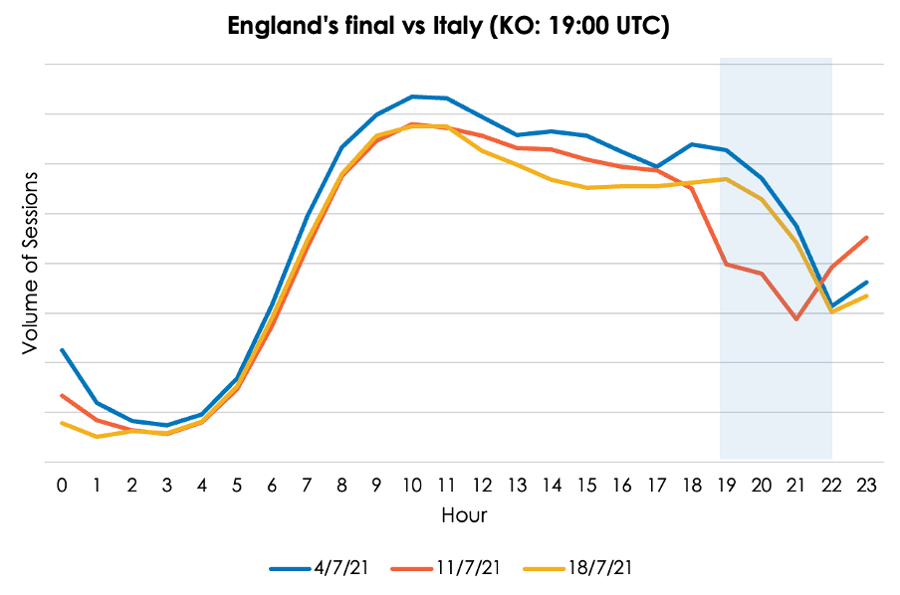UEFA Euro 2024 kicked off on Friday, with Scotland’s match against Germany in Munich (the Germans opened the tournament with a 5-1 win). The Copa América starts later this week, and Paris hosts the Olympics at the end of July.
With so many major international sporting events on the calendar this summer, we decided to take a look at how these worldwide spectacles can impact fraud.
In the past, BioCatch researched the impact the 2018 and 2022 FIFA World Cups had on the fraud space and uncovered some interesting trends. Let’s take a look back at what we discovered from these analyses and explore if these trends also can be extended to a regional tournament like the European Championships.
Look back: Russia 2018
Looking at data from the Russian World Cup, we saw the number of cyber-attacks declined significantly in countries with a significant football following: Mexico saw an 87% decrease, while Brazil saw 21% fewer attacks. Interestingly, in England, the attacks increased by 24% during their games, but when Russia played, attacks in England declined (suggesting Russian cybercriminals were targeting the country).
Moreover, general traffic was down across all three countries, with a 12%, 31% and 6% decrease respectively in people connecting to their online banking during this time.
Look back: Qatar 2022
We saw a similar trend in 2022. In the group stages, matches in Argentina and Brazil led to a slight decrease in general digital banking activity:


There is an obvious drop in volumes during the match itself, but we also see a slight drop during the pre- and post-game, suggesting people were otherwise occupied, and considering both these nations are keen football fans, one could assume their eyes were on TV screens rather than computers/mobile devices.
However, it’s as the teams progress or fail to progress in the competition when the changes in behaviour become most evident.

Brazil reached the quarterfinals in 2022, the stage at which they were eliminated. In contrast to their group-stage match, where we perceive a significant decease during the match and a slight decrease in the buildup and post-game, after losing this match, normal login activity resumed, suggesting the lack of celebration led users to go about their normal activities.

In the case of Argentina, in their semifinal, we see a prolonged decrease in activity, which intensifies while the match takes place.
When they reach the final, the drop during the match itself is the biggest we see – just a third of the activity seen compared to the previous week. The drop in activity also lasts longer, with the match reaching penalties and then – after Argentina wins the tournament – in-country celebration ensues.
When it comes to analysing the fraud, there is a stand-out stat: The day of the final, fraud volumes in Argentina dropped by 93% compared to the daily average for the previous week. It’s worth noting that for Argentinian banks that use BioCatch, almost 95% of all fraud during the World Cup originated in Argentina. Therefore, it goes to say that fraudsters also got behind their national team the day of the final.


Euro 2020
For this analysis, we will focus on the later stages of the tournament, where the impact is greater, based on the analyses of the World Cup. In particular, we will take a look at two countries: England, who reached their first international final since 1966, and Spain, who reached the semifinals.
The first match Spain played in the knockout round was against Croatia – runners up in the previous World Cup (Russia 2018) – which garnered high interest that resulted in almost 60% viewership in Spain.
As with previous analyses, we have looked at the session volume on the day of the match and compared it to the same weekday in the following and previous weeks. The day of the match (orange line) is almost identical to that of the following week (yellow line) throughout all the day until the match begins. At that point, we see a drop of 15% in session volumes.
 The semifinal match Spain played against Italy was the most watched match of the entire tournament in Spain, with viewership in the country estimated at 68%.
The semifinal match Spain played against Italy was the most watched match of the entire tournament in Spain, with viewership in the country estimated at 68%.
In this case, we see behaviour changed week-on-week, partly due to the naturally occurring variance as a result of month-end (blue line), which typically sees very high volumes, and mid-month activity (yellow line), where volumes are reduced. While we do not have a like-for-like comparison, as with the previous match, we do see a drop in volumes as the match begins.
In fact, while we see that session volumes are down by approximately 15% during this day compared to the previous week, as the match starts, this drop increases to 27% and peaks at 33%.

As expected, we see a drop in general activity as these important matches take place.
If we now focus on England, the difference is even bigger. It is also worth noting that BioCatch customers analysed for this are UK banks, with presence across the four nations. It is likely those in Scotland, Wales and Northern Ireland had no interest whatsoever in any of these matches, and likely did not change their behaviour at all, leading to “watered down” results.
Going straight to their semi-final match, we see a similar trend. General volumes are comparable on match day to those of the following week. But, as the match begins, we see volumes drop by 25%. Looking even closer, we see that volumes start to drop more than an hour before kick-off, which could be explained by people drinking prior to the match.

And now, looking at the main event, we see even bigger differences of up to 53%. Interestingly, there are two points to note on this:
1. As the match goes to extra-time, there is an increase in volumes.
2. Once the match is over, there is a spike of up to 56%, compared to the lowest point during the match.
While the latter is easily explainable by people returning to normal behaviour, the former is peculiar and somewhat more difficult to understand. Considering the influx of betting activity around football matches, one possibility is people cashing out or placing new bets on the outcome that may require online banking.

Another insight we see around the England matches is around reported frauds/scams.
During the month the tournament was held, our UK-based customers reported several thousand sessions as frauds or scams, with an average ratio of 2:1 in terms of scams to fraud. Not only do we see less fraud on match days we have also observed that the ratio of scams decreases, with a 15% reduction in voice scams on match days.
Interestingly, the fraud sessions were shorter too. While 50% of all reported frauds/scams lasted more than 20 minutes during the month the tournament took place, only 35% of reported fraud sessions were that long on the day of the final.
Likewise, the majority of fraud sessions (56%) lasted between two and 10 minutes on the day of the final. With fraud taking less time, one could interpret this as fraudsters being rushed, and since the vast majority of reported frauds took place from within the UK based on location data, it would seem fraudsters are also football fans, eager to get their business done with so they can devote all their attention to the match.
What we see, once again, is that these events are far-reaching in their impact on society, to the point where it affects how we – and fraudsters – go about daily activities, including our banking habits.
As this year’s tournament gets rolling, it’s good to keep this in mind and be aware of potential customer behaviour changes. Let’s make sure the fraudsters get sent home early.





